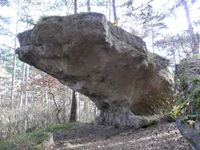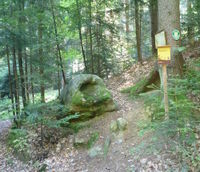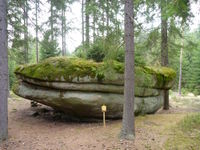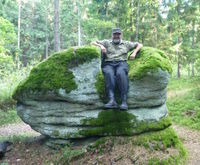Tag:natural=rock
| Description |
|---|
| A notable rock or group of rocks attached to the underlying bedrock |
| Group: natural |
| Used on these elements |
| Useful combination |
|
| See also |
| Status: approved |
| Tools for this tag |
|
natural=rock describes a notable rock feature or small group of rocks, attached to the underlying bedrock, mostly used on a single node element.
On the contrary, single boulders not attached to the bedrock are better tagged as natural=stone.
For larger bedrock areas you may use natural=bare_rock.
Note that as this distinction may not be obvious to everyone from tag names, a large part of objects was tagged without following that distinction. In addition, in many cases mapper may want to map feature and have no ability/desire/time/knowledge to check bedrock connection. This supposed difference may exist only in OSM Wiki documentation.
Consider adding geological=outcrop to natural=stone/natural=rock where it is attached to underlying bedrock, such additional tag is much better fit for such detail which is often tricky or impossible to survey. This avoids forcing mappers to map distinction which they are not aware about or do not care about or are unable to distinguish.
Examples
Note that for many mappers (most? nearly all?) it is not clear whether these “stones” are attached to bedrock and how to check it. In addition large part of them do not care at all about such distinction, and will not start just because OSM Wiki documentation instructs them that making this distinction is mandatory while mapping stones.
1446482596
 1446482596
1446482596
1221140868
 1221140868
1221140868
1416657234
 1416657234
1416657234
1885717635
 1885717635
1885717635
979398379
 979398379
979398379
Tag history
Strong distinction between rocks attached to bedrock and not attached to bedrock is present in German but not in English[1]. It is one more case of OSM tag design following German terminology.
This tag was suggested for mapping areas of rocks and small skerries that can be used for navigation or that might be a potential danger for navigation.
![]() Please note: this tag is in use but natural=bare_rock has been approved for general rocky land areas.
Please note: this tag is in use but natural=bare_rock has been approved for general rocky land areas.
This tag was also used during the French Corine Land Cover (See details on the french page) to import areas made of solid rocks (opposed to natural=scree) Those areas can be seen in mountains or near coast.
The proposal for natural=bare_rock was also originally the page proposing natural=rock. Talk:Proposed features/bare rock#More descriptive tag name is the discussion related to this.
The documentation and use of geological=outcrop in 2012 has rendered the distinction between "attached" and "loose" rock for this tag less relevant, as any rock that is attached to the surface can be tagged with geological=outcrop to clarify this. Due to the difference between the way natural=rock is documented on the wiki and the actual semantic meaning of rock as opposed to stone, it may be the case that many loose rocks have simply been tagged as natural=rock. Consider that instead of tagging these with the less specific natural=stone, it may be more helpful to tag rocks that are attached to the ground as geological=outcrop instead.
Similar tags
- natural=bare_rock - areas of visible solid bedrock
- natural=stone - large boulders and rocks (glacial erratics or rock fall) not attached to the bedrock, mainly single node element
- natural=scree - loose angular rock fragments
- natural=glacier - glaciers
- natural=cliff - a significant vertical or near vertical rock exposure
- place=island and place=islet for island 'place' tags (which could be used in combination with 'natural' tags)
- OpenSeaMap/Rocks - seamark:type=rock, seamark:rock:water_level=*
See also
Proposed features/natural=rock cleanup (Proposed 2013, approved 2014)
- ↑ https://github.com/openstreetmap/iD/pull/6311 - see "If you wonder why there are these two tags at all" part
https://geologywriter.com/blog/stories-in-stone-blog/rock-or-stone-is-there-a-difference/ mentions that terms are used interchangeably even in materials concerning this topic, though in specialist language this two terms can be differentiated. But it is not happening in common language
https://www.merriam-webster.com/dictionary/stone https://www.merriam-webster.com/dictionary/rock also does not indicate difference that would match attempted distinction in OSM tagging




